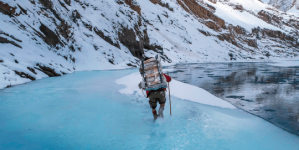-
UNION INTERIM BUDGET 2024-25 -
-
Are cryptocurrencies the future of the digital world economy -
-
Breaking Waves, Breaking News: Lakshadweep’s Recent Developments Explored -
-
The Impact of the Digital Economy on Business and Society -
-
Augmented Marketing: A Comprehensive Guide -
-
How To Strengthen Your Email Marketing Using AI -
-
How Artificial Intelligence and Digitization Are Transforming Our Lives -
-
What Data Science Tools do the Experts Recommend? -
-
Robotic Process Automation Will Transform Your Business? Check Here! -
-
Edge Computing: How it is Reshaping Cloud Infrastructure -
Travel & tourism investment to rise by 6.7 per cent per annum
New Delhi: Addressing the fourth tourism investors meet organized by FICCI in the capital, Usha Padhee, Joint Secretary, Ministry of Civil Aviation, Government of India said that the tourism and civil aviation ministries are engaging continuously to identify solutions and to implement them for the growth of both the sectors. Various people from tour and travel industry participated in the meet.
“The way forward is a focused approach for evolving tourist places under the aviation connectivity scheme and expanding existing routes under UDAN scheme including helicopter routes in hilly and north-eastern regions. This will provide good infrastructural support to the tourism sector,” said Padhee.
She also added that the ministry of civil aviation is working to remove bottlenecks in remote and regional areas by providing proper navigation means, technology, better security and safety.
Dr. Jyotsna Suri, Past President, FICCI & Chair, FICCI Tourism Committee and CMD, Lalit Suri Hospitality Group, in her address said that increasing connectivity will boost tourism, adding that ‘one flight per day to Khajuraho will build the demand eventually’.
Dipak Deva, Co-Chair, FICCI Tourism Committee and MD, SITA, TCI & Distant Frontiers also presented his view on the growth of tourism in the country.
A FICCI-YES Bank knowledge paper on Tourism Infrastructure was also released by the dignitaries.
Highlights of FICCI-YES Bank Knowledge Paper on Tourism Infrastructure
As a global growth engine, tourism offers opportunities for both skilled and unskilled segments of the labour force. With rising demand for tourism products, many new destinations have emerged that are competing to garner larger footfalls, and many businesses within destinations are also competing. Infrastructure development is a prerequisite to gain higher tourist numbers and requires the combined effort of the host community, tourists and private and public sectors.
The following measures are suggested in the knowledge paper that can accelerate the growth of tourism infrastructure in the country.
Tourism Specific Ease of Doing Business (EoDB) Rankings
‘EoDB Tourism State Rankings’ can be introduced with comprehensive parameters for assessment of State initiatives. A uniform format can be introduced for collection and publishing of tourism data and statistics across states and districts to facilitate easier decision making by investors and also measure the impact of initiatives of various states and other stakeholders.
Private Sector Participation for O&M of Existing Government Infrastructure
There is a large inventory of tourism infrastructure owned by state tourism departments as well as interconnected sectors like forest bungalows, many of which boast of exquisite locations that are lying idle or have further potential to upscale and attract more visitors. The private sector can be roped in to operate, improve or refurbish such properties and thus also boosting the room inventory.
Promote Smart and Frugal Infrastructure
As we expect tourism models to uplift communities, the creation of modern infrastructure will be pivotal towards attracting tourists, even more so in remote and offbeat locations. Currently, the minimum project cost for tourism projects to qualify for infrastructure status is INR 200 Cr, which is under consideration to be lowered to INR 50 Cr. However, if this entry barrier can be further lowered, or a separate incentive scheme can be carved out for smaller projects, it will encourage private players to participate in small infra.
Promote MICE Sector
While MICE sector has experienced growth in the Indian sector in the past decade, India still has less than 0.5% share of the world meetings and conventions market. Developing more world-class exhibition centres can enable India to attract global conventions and meetings in tourism as well as other sectors.
Incentivize Private Sector Participation
Government/(s) should incentivize private players to invest in unserved/ under-served tourism projects. The incentive pattern can be friendlier for attracting more innovative tourism projects vis-a-vis run-of-the-mill projects. For instance, interest subvention scheme can be introduced for small tourism projects like community homestays, RO-RO and boat operators. Additional incentives, like additional interest subvention post COD, can be provided to projects (incl. new Hotels and resorts) at tourist destinations with limited tourist facilities and connectivity.
Online Repository of Land Banks
Availability of suitable land is one of the main concerns for investing in tourism projects, especially when it comes to sustainable tourism infrastructure in fragile areas. The states need to develop land bank outlining the land parcels available for tourism projects, which are made accessible over an interactive web platform with the support of Ministry of Tourism. This will enable investors to assess the preliminary viability of their projects basis the nature of land parcel/ select the appropriate land parcel suitable to the proposed project.
Medical and Wellness Tourism
India holds a competitive advantage in offering these products and services and is also one of the most competitive destinations offering specialized treatments at low costs. The need of the hour now is to attract investments to create a supporting infrastructure that can help reap dividends of this global movement led by India, as well as further consolidate offerings in allopathic healthcare and advanced medical procedures.
Coastal Area Development
Blessed with almost 7,500 km of coastline, beaches/ Coastal tourism forms one of the top tourism themes in India and is also a preferred theme for foreign tourists visiting India. To leverage on this coastal advantage of India, priority can be accorded for identifying a minimum of 100 coastal destinations/ beaches and develop the basic tourism infrastructure in addition to ensuring cleanliness at these locations.
Leveraging MSME funds
India’s immense cultural and natural heritage is managed and conserved by local communities and small entrepreneurs whose business models now require scale-up through capital infusion, capacity building and skill building support. Convergence of Government Schemes with organizations like NABARD, SIDBI among others can be channelized into developing tourism infrastructure in rural and hinterland areas.
Technology for Infrastructure Assessment and Management
Today’s technologies give us clear insights and easy to use tools to advance sustainable and inclusive growth and go far beyond cashless transactions and reservations. Data analytics can provide insights into consumer spending and movement trends which can further facilitate municipalities on crowd management and urban planning. Enabling a cashless ecosystem for tourists, introducing value-added products like Incredible India Travel Card, application of GIS and emerging technologies, like Artificial Intelligence (AI) are some possible areas of intervention.
According to the report, travel and tourism investment is expected to rise by 6.7% per annum over the next ten years to INR 5,546.3 billion in 2028.
Rana Kapoor, MD & CEO, YES BANK and Chairman, YES Global Institute said that unlocking the true economic potential of the tourism sector will require sustained efforts to augment and modernize tourism infrastructure in the country and will need to be driven by a partnership-led approach between the Government and the private sector through innovative PPP models.































